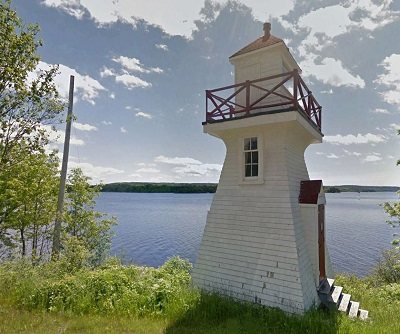Bayswater Lighthouse
Heritage Lighthouse
Bayswater, New Brunswick

Bayswater Lighthouse
(© Fisheries and Oceans / Pêches et océans)
Address :
2095 NB-845, Bayswater, New Brunswick
Recognition Statute:
Heritage Lighthouse Protection Act (S.C. 2008, c 16)
Designation Date:
2018-05-25
Dates:
-
1913 to 1913
(Construction)
-
1914 to 1914
(Established)
Description of Historic Place
The Bayswater Lighthouse is a traditional, square tapered wooden tower, standing 8.8 metres (29 feet). It was constructed in 1913, and has been deactivated since 2005. The lighthouse is located on a small parcel of land on the west side of the Milkish Channel, on the lower Saint John River, in New Brunswick.
Heritage Value
The Bayswater Lighthouse is a heritage lighthouse because of its historical, architectural, and community values.
Historical values
The Bayswater Lighthouse is a very good example of the expansion of navigational aids to improve shipping and passenger traffic along the Saint John River from the mid-19th century into the 20th century. This corridor, which travels 673 kilometres from the province of Quebec and the state of Maine to the Bay of Fundy, was a key shipping and passenger route in New Brunswick. By 1914, Bayswater was one of 21 operating lighthouses along the Saint John River system and served river traffic and a ferry that ran between the community of Bayswater and Millidgeville, just to the north of the city of Saint John. Though the ferry ceased operations around the 1950s, the lighthouse continued to guide personal watercraft, fishing boats, touring vessels, and recreational canoes and kayaks along the “Rhine of North America”, a nickname for the lower Saint John River due to its popularity among boaters. The lighthouse was deactivated in 2005.
Architectural values
The Bayswater Lighthouse is an excellent example of the typical “pepper pot” lighthouse, with a square tapered wooden tower. It is distinguished by its coved cornice tower, which gives it an attractive, graceful and balanced appearance to an otherwise simple structure. The lighthouse is painted red and white, the traditional colours of the Canadian Coast Guard. Initially equipped with a Fifth order lens, the light was changed to fixed red light during the 1960s-1970s and in 2004 became a flashing red light.
Built in accordance to a standard plan of the Department of Marine and Fisheries, this model was popular from the 1860s well into the 1930s. The utilitarian design was inexpensive and easy to build, and provided a stable platform for the lantern and light. These small wooden towers were also relatively easy to maintain by a local lightkeeper.
Community values
The Bayswater Lighthouse is situated alongside a rural highway along the lower portion of the Saint John River. It is surrounded by trees with a few houses dotting the forested area. The site is relatively unchanged from its original setting. Visible from the water and the roadway, the lighthouse remains compatible with its riverside environment.
With its prominent location along Highway 845, the lighthouse welcomes travellers into the community. Although it has been inactive since 2005, it remains a highly valued heritage and tourism symbol for residents and mariners alike.
Related buildings
No related buildings.
Character-Defining Elements
The following character-defining elements of the Bayswater Lighthouse should be respected:
its location on a small parcel of land on the west side of the Milkish Channel; its intact, as-built form and proportions, based on the standard design of square, tapered, wooden towers; its square wooden frame structure with tapered sides rising from a square base; its wooden structural form, historically sheathed in wooden shingles; its gallery, supported by a flared, coved cornice that transitions from the tapered walls; its pedimented door; its two windows on opposing façades providing natural light to the interior; the design and material of the plain iron railing that surrounds the gallery; its original square lantern with pyramidal roof and vent; its traditional red and white exterior colour scheme, consisting of white for the tower and cornice, and red for the lantern, the gallery railing, and the door; and, its visual prominence in relation to the roadway, water and landscape.